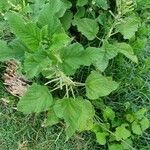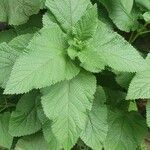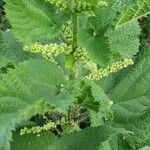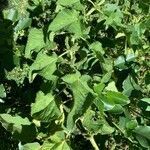Erect perennial dioecious herb up to 2 m. tall, with little-branched ± quadrangular stems, forming loose clumps from a creeping rhizome; all parts of plant with fiercely stinging hairs 1.5–2 mm. long, raised on protuberances ± 1 mm. high, otherwise glabrous to puberulous.. Leaves: stipules fused, interpetiolar, (0.8–)l–2 cm. long, 0.4–1 cm. wide, with rounded apex and broadly cuneate to cordate base, chartaceous, brown; petioles 1.5–4.5 cm. long; lamina ovate, 7–13 cm. long, 6–10.5 cm. wide, base cordate, margin serrate or usually double serrate, with numerous teeth on each side, apex acute to shortly acuminate; lateral nerves 6–9 pairs, lower 2–3 pairs running into subcordate leaf-base, all pairs extending to leaf-margin and linked by a fine net of anastomosing nerves; upper surface with stinging hairs and sometimes also a fine pubescence, cystoliths very numerous, punctiform, lower surface with stinging hairs along the nerves.. Inflorescences paired in the axils of the upper leaves, spike-like, 2.5–4.5 cm. long, with the flowers in small, densely cymose, bracted glomerules, sometimes the inflorescence with a few side-branches near the base.. Male flowers on pedicels 0.8–1.5 mm. long; perianth ± 1 mm. in diameter, puberulous to pubescent, occasionally with a few stinging hairs, depressed globose in bud.. Female flowers sessile; perianth ± 1 mm. long, pubescent, with numerous stinging hairs on the large pair of tepals.. Achene flattened, ovoid, ± 1 mm. long, 0.8 mm. wide, white, long enclosed in the persistent perianth but dispersed without it.. Fig. 1.
More
It is a stinging nettle. It is like Urtica simensis but is more robust and has double teeth around the edges of the leaves. It is a herb that keeps growing from year to year. It grows 2 m high. The stinging hairs are 2 mm long. The leaf stalks are 4.5 cm long. The leaf blades are 7-13 cm long by 6-11 cm wide. There are double teeth along the edge. The flowers are of one sex. The fruit is oval, flattened and dry. It is 1 mm long.
Grows well in gaps, on disturbed ground in montane forests, near human habitation, around cattle enclosures, in abandoned fields and in secondary bushland after clearing of forests in high-altitude areas, at elevations from 1,500-3,200 metres.
More
A tropical plant. In Kenya it grows in moist bushland between 1,500-3,250 m altitude. It grows in loose soils with plenty of organic matter.






